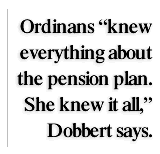Karen Ordinans’ Role in Shaping the Pension Plan
One of the remarkable stories in local government is the continuing survival of County Board chair Karen Ordinans. Tom Ament and several of his key aides were forced out of office, and recall petitions have been completed against five county supervisors, including Linda Ryan and David Jasenski, who had little power over the pension plan. You’d have thought that Ordinans, second-in-command to Ament, would have been the first supervisor to go, yet there hasn’t been much criticism of her. Recall organizers say they now have enough signatures to recall Ordinans, but they have yet to turn in any paper work.
 Ordinans has handled the situation rather brilliantly. As soon as the Milwaukee Journal Sentinel‘s blitzkrieg of pension stories started, Ordinans called on Ament to fire his top aides. She later led board members in calling for Ament’s resignation as well. She has consistently posed as the leader of reform efforts, and has offered persuasive testimony that she was misled by the Ament administration. Should we believe her?
Ordinans has handled the situation rather brilliantly. As soon as the Milwaukee Journal Sentinel‘s blitzkrieg of pension stories started, Ordinans called on Ament to fire his top aides. She later led board members in calling for Ament’s resignation as well. She has consistently posed as the leader of reform efforts, and has offered persuasive testimony that she was misled by the Ament administration. Should we believe her?
Ordinans became board chair in 1997 at a tough time, when Ament had amassed tremendous power. Ament not only had the executive power, but had an easy time getting a majority vote of the board on most issues. This made Ordinans less powerful than past board chairs, but she still had considerable clout. So what did Ordinans know about the pension plan and what was her impact on it?
Ordinans, however, says that because of her prior background, she was “very conscious” of not looking like she was biased in favor of unions, and made a point of not interfering in labor negotiations. “The Department of Human Resources and the Department of Labor Relations historically had a great latitude in handling labor agreements,” she notes.
But Gary Dobbert, former head of human resources and the chief architect of the pension plan, says Ordinans did involve herself. “She knew everything,” he says. “She knew it all. [Former corporation counsel] Bob Ott and I met with her and went over the entire package before it was drafted. I talked to her several times and I know she had talks with Tom Ament and [former Ament aide] Tom Mollan.”
Dobbert also says he explained the backdrop and “she knew about the lump sum payments.” But Ordinans says “I was told by Gary it [the backdrop] was cost neutral.” Certainly the memos of the time support that contention. And Dobbert, who Ordinans wanted Ament to fire, would certainly have reason to paint her in the worst possible light.
But certain aspects of Ordinans’ defense seem suspect. Even if she didn’t understand the backdrop, why support the incredible 25 percent increase in pension benefits for employees hired prior to 1982, which in effect allowed employees to grab more than 100 percent of their salary for their annual pension payment? Ordinans answer? “I repeatedly asked [former head of labor relations] Henry Zielinski if we could afford this and the answer was yes.”
But why not order your own investigation of this question rather than taking the word of the Ament administration? And even if the county could afford it (which we now know is untrue), what justification was there for offering such an unprecedented benefit?
The answer is that Ordinans wanted to bring all the newer (post-1982) employees up to the same level the older employees had long enjoyed. She wanted them to get 2 percent of their salary for each year worked applied to their pension payment, rather than 1.5 percent. That half percent sounds small, but over the course of say, 35 years of work, would mean an employee could collect 70 percent of his/her salary rather than 52.5 percent. It was a big number, and older employees would also have to get a big handout or they might not support the plan. “They said, Karen, if you really want the two percent, then we have to do something for those already at two,” Ordinans says.
Ordinans, it seems, was willing to accept that bargain. She also seemed to trust Dobbert. “I have always known Dobbert to be a hard worker,” she says. “I had a lot of experience working with him through my AFSCME experience.”
Ordinans admits that prior to passage of the pension plan, Dobbert and other Ament aides came to her and asked her to remove Supervisor Robert Krug as the head of the personnel committee. “They expressed their conviction that Krug was difficult to work with,” she says.
So Ordinans replaced Krug, who had spent four years immersing himself in the details of the county personnel issues, with Supervisor Kathleen Arciszewski, who has since proven to the entire community that she is over her head on these issues. If Ordinans truly intended not to interfere in labor negotiations, then the personnel committee would have become the board’s main line of defense. Why would Ordinans appoint a dim bulb like Arciszewski to protect the taxpayers?
The sum total of Ordinans’ decisions points to either incredible ineptitude on her part or a deliberate decision to go along with the Dobbert/Ament approach. Given Ordinans’ obvious intelligence, I favor the latter theory, but either explanation is very damning. If Ordinans does face a recall effort, she will have a lot of explaining to do.
The Great Cofrin
The death of Doug Cofrin a month ago got some press, but the obituary didn’t quite capture the spirit of the wacky, Fort Howard Paper Co. heir. Cofrin bought the classical music station WFMR in the 1970s, and was something of a legend for his eating habits and for other things he ingested, sometimes on the air according to his fellow deejays at the station. The motorcycle-riding free spirit then started Milwaukee Magazine as a spin-off of the station’s program guide. Cofrin graced the cover of Milwaukee Magazine in a sarong (writing about his Hawaiian vacation) and wrote restaurant reviews (specializing in pizzas and fish fries) under the name G.W. Walker. The name was derived from “The Ghost Who Walks,” another name for The Phantom, Cofrin’s favorite comic strip character.
Cofrin was so strapped after his expensive defeat, he was forced to sell the radio station and the magazine. “It was five and twenty blackbirds,” he once recalled of the magazine’s sales price — $25,0000.
Cofrin sold the publication to the Cleveland-based City Magazines, and the new editor of Milwaukee Magazine included a tongue-in-cheek obituary for G.W. Walker, noting his passing after choking to death on a pizza.
The magazine was later sold to Quadgraphics, the current owner. As for “The Great Cofrin,” as Doug liked to call himself, he faded from the spotlight, living comfortably on the $2 million he made selling the radio station.
This article was originally published by Milwaukee World.
More about the Milwaukee County Pension Scandal
- Back in the News: Actually, County Comptroller Could Get $1.3 Million Backdrop - Bruce Murphy - Jul 12th, 2023
- MKE County: Pension Backdrop Costs Hit $354 Million - Angeline Terry - Aug 16th, 2021
- Murphy’s Law: Mr Pension Scandal Wants Your Vote - Bruce Murphy - Jul 22nd, 2020
- Murphy’s Law: Schmidt’s Pension An Issue for Deputies - Bruce Murphy - Aug 13th, 2018
- Murphy’s Law: Schmidt Will Get $1 Million Pension - Bruce Murphy - Aug 2nd, 2018
- Murphy’s Law: Schmidt Pension At Issue In Sheriff Race? - Bruce Murphy - Aug 2nd, 2018
- The $400 Million Pension Problem - Mitchel Writt - Jun 6th, 2017
- Eyes on Milwaukee: Will County Give Pension to State? - Jeramey Jannene - Mar 23rd, 2017
- Murphy’s Law: Who’s To Blame for Pension Mess? - Bruce Murphy - Mar 7th, 2017
- Murphy’s Law: County Pension Scandal Poster Boys - Bruce Murphy - Mar 3rd, 2016
Read more about Milwaukee County Pension Scandal here
Murphy's Law
-
Is Legislature Biased Against Working Class?
 Apr 4th, 2024 by Bruce Murphy
Apr 4th, 2024 by Bruce Murphy
-
Associated Press Will Decline in Wisconsin
 Mar 27th, 2024 by Bruce Murphy
Mar 27th, 2024 by Bruce Murphy
-
City Attorney Race Is Vitally Important
 Mar 25th, 2024 by Bruce Murphy
Mar 25th, 2024 by Bruce Murphy
















